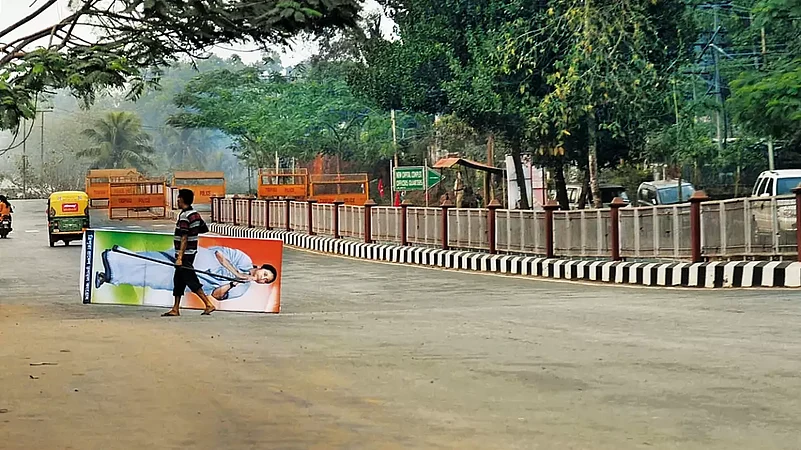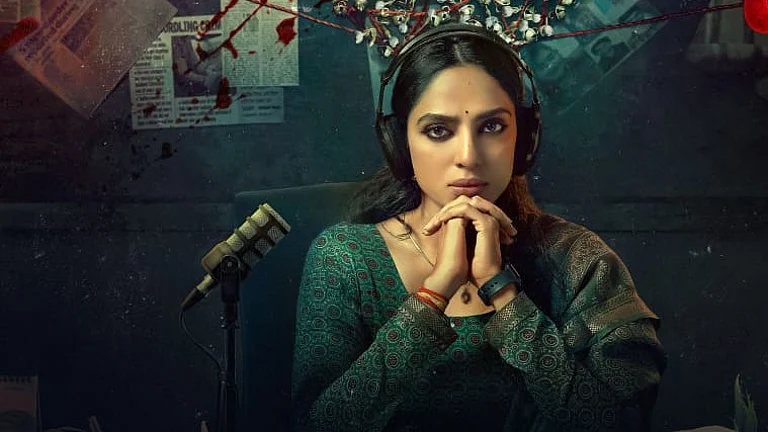“Everybody knows how attacks on Christians have increased all over the country since the BJP (Bharatiya Janata Party) came to power in 2014. Churches are being vandalised. Father Stan Swamy was killed in jail,” Justine G. Momin, the Trinamool Congress (TMC) candidate from Mawshynrut, a remote constituency in Meghalaya’s West Khasi Hills district, tells a small gathering of locals at Shallang, about 170 km west of the state capital, Shillong.
It was evening on February 2. People gathered there had started wearing warm clothes as the temperature dipped in the sparsely populated, mostly arid, coal-rich, hilly terrain, lying near the border of the Garo and Khasi Hills. Tribals and Christians form about 98 percent of Mawshynrut’s population. Momin continued, “Yet the NPP (National People’s Party) gave the BJP scope for backdoor entry to power and they ran the government together for five years. Did they ever raise their voice against attacks on Christians? They are the BJP’s B-team. They are exposing Meghalaya’s Christians to grave danger.” In a state where Christians make up three-fourths of the population, getting branded anti-Christian can be harmful for any political party. The TMC is trying to do exactly that to the ruling NPP. However, local outfits are beating the TMC at its own game.
On January 28, Mukul Sangma, the leader of the opposition in the Meghalaya Assembly and the TMC’s chief ministerial face, arrived to campaign for Momin and lambasted the NPP-led coalition government that included the BJP, the United Democratic Party (UDP), the People’s Democratic Front (PDF) and the Hill State People’s Democratic Party (HSPDP). Targeting the regional parties for “tying up with an anti-minority force,” he accused them of failing to fulfil their promises. After the meeting, local leaders of the NPP and the HSPDP visited the Shallang neighbourhood and branded the TMC as an ‘outsider’ and a ‘Bengali party’. They also circulated news reports about a West Bengal minister’s allegedly distasteful remarks on President Droupadi Murmu and dubbed the TMC as ‘anti-tribal’.
In Meghalaya, where ethnic conflicts provide most of the political fault lines, labels like ‘Bengali party’ or ‘anti-tribal’ cannot be taken lightly. Tribals make up 86.15 percent of the state’s population, according to the 2011 Census. Bengalis living in Shillong have frequently found themselves at the receiving end of tribal–non-tribal conflicts.
Therefore, Momin, like every other TMC candidate, is busy countering the tag ahead of the February 27 election. The attack comes from none other than Conrad Sangma, the incumbent chief minister and NPP leader, who routinely dubs the TMC as an ‘outsider’. “Mamata Banerjee had branded the BJP as an outsider ahead of the 2021 Bengal elections. By the same analogy, the TMC is an outsider here. It is Bengal where it belongs,” Conrad tells the gatherings at all his rallies.
The campaign against the TMC started nearly a year ago and Banerjee, during her visits to Meghalaya in December and January, had tried to shed this image. “Ours is not a Bengali-only party. I work for all of India,” she had said, while elaborating on how she was in love with Meghalaya. However, the NPP’s campaign only increased in pitch following her visits.
The TMC entered Meghalaya’s political scene with a bang in November 2021 when Mukul Sangma, two-term former chief minister, deserted the Congress and joined the TMC, along with 11 MLAs. It became the main opposition party literally overnight. As party subsequently lost its remaining five MLAs to the NPP and the UDP, the Congress was relegated to the fringes and the TMC emerged as the NPP’s main rival.
“The way all regional parties are targeting us on TMC’s Bengali origins shows the kind of panic we have created among the BJP’s ‘B-teams’,” says Fernandes Dkhar, the party’s Meghalaya youth wing chief and a candidate from the Rambrai-Jyrngam constituency, talking to Outlook, in between election rallies, “The TMC has given us the slogan ‘Maa–Mati–Manush’—mother, motherland and people. What could be more apt for Meghalaya’s people?” he asks.
Complex History, Complex Equations
Political equations in Meghalaya have always been complex as no party has managed to gain a clear majority in the state since 1978. In 2018, the BJP, which had won only two seats, helped the NPP, which had bagged 19 seats, quickly forge a coalition government with support from six MLAs of the UDP, four MLAs of the PDF, two HSPDP legislators and Independents.
This time, all parties have decided to go solo. The TMC, the NPP, the BJP and the Congress are contesting from all 60 seats, while the UDP from 45, HSPDP from 11 and the PDF from six. Two more players, the Voice of the People Party (VPP) and KAM Meghalaya, both newly launched outfits, have fielded 16 and three candidates, respectively. To add to the twist, as many as 13 MLAs switched camps in December and January, which is likely to have changed many equations locally.
There are regional differences in voting patterns as well. The Khasi–Jaintia Hills, which have 36 seats, usually give a split verdict, while the Garo Hills with 24 seats tend to go strongly behind one party at a time. All regional parties have their bases in the Khasi–Jaintia Hills.
The Garos, who live mostly in the Garo Hills, and the Khasis, who dominate the demography in the Khasi–Jaintia Hills, have their internal conflicts, each demanding separate statehood, which influence electoral outcomes. Though the demand for a Garoland is missing this time from the electoral arena, the HSPDP has pledged to persist with its demand for statehood for the Khasi–Jaintia region. The UDP, on the other hand, is urging people to elect a Khasi chief minister—both Conrad and Mukul are Garo.
All these factors make elections in the Khasi–Jaintia Hills multi-corner contests, while the Garo Hills are expected to witness mostly three-corner contests, where both the NPP and the TMC would face challenges from the UDP in some seats and the BJP in others.

“If we can bag the majority of seats in the Garo Hills, which is our stronghold, we will stay ahead of others in the race,” says a member of TMC’s Meghalaya state committee. “No party will be able to sweep the Khasi–Jaintia Hills,” he adds.
Take Mawphlang, for instance, a constituency in East Khasi Hills district, where the NPP, UDP, BJP, HSPDP, PDF, TMC, VPP and the Congress have fielded candidates. The constituency elected an Independent in 2018 but the UDP won the seat in the 2021 by-election. “There is no clear favourite. The NPP and UDP have better chances than the others but no one can be sure,” says James Dkhar, a resident of Mawngap village in the constituency. Similar is the situation in neighbouring Sohiong. “If we fare better in the Garo Hills and the UDP in the Khasi–Jaintia Hills, plans are afoot to quickly forge an alliance with them to keep the NPP and BJP out of power,” says a senior TMC leader, unwilling to be named.
Sops versus Identity
Revealing its intent, the TMC not only announced its first list of 52 candidates but also released its manifesto before the NPP, the BJP and the Congress, among others, which included massive promises that the incumbent chief minister says are impossible to implement. The TMC has promised monthly financial assistance of Rs. 1,000 to every woman and unemployed youth aged between 21 and 40 years, vowed to dump the Memorandum of Understanding that Conrad Sangma had signed with Assam regarding border disputes, promised to create 3 lakh jobs and pledged to find solutions to resume coal mining, banned by the National Green Tribunal in 2014, one of the biggest economic issues in this election. The NPP, while calling the TMC’s financial assistance scheme absurd, has promised to create 5 lakh jobs through entrepreneurship if it came to power.
However, amid raining sops, it is identity politics that every party is banking on to sail through choppy waters. In the Khasi Hills, the ‘Bengali party’ tag seems to have struck a chord with a section of voters. Asked about who they thought were the main contenders, voters in several constituencies mostly named the NPP, the UDP, the HSPDP and even the VPP. “The TMC is campaigning a lot, but it is a new party,” says R.J. Thangkhiew, a voter of Nongstoin assembly constituency.
According to journalist and author, Samrat Choudhury, who grew up in Shillong, the campaign branding the TMC as a ‘Bengali party’ is likely to strike a chord with local, tribal people in the Khasi Hills which may affect TMC’s chances there. “The anti-Bengali sentiment has a long history there and the Bengalis of Shillong know it only too well. They remember the riots against them by the year. That is why I think it is a strategic mistake for the TMC to bring in leaders from West Bengal for campaigning,” says Choudhury, co-editor of the book Insider/Outsider: Belonging and Unbelonging in North-East India.
“They would have possibly done better if they left the campaign to local leaders. A Bengali face in the Khasi–Jaintia Hills is not a plus. If I-PAC (Indian-Political Action Committee) is engaged with the TMC in Meghalaya, either they did not advise the TMC sensibly or their advice was not heeded,” he adds. Teams from I-PAC, a political consultancy firm which worked with the party in West Bengal, are also camping in Meghalaya to assist party candidates in localised strategising, though not on the same scale as they were in West Bengal.
TMC in the Northeast
Political observers see the Meghalaya elections as the TMC’s best chance for expanding in the Northeast, a region it has been eyeing since its inception in 1998. The party failed to build on some successes it had in the beginning.
In 2004, the party got a breakthrough in Meghalaya when former Lok Sabha speaker P.A. Sangma, who had left the Nationalist Congress Party (NCP), won from Tura Lok Sabha constituency. This success was short-lived, as Sangma returned to the NCP the next year. In 2012, the TMC emerged as the main opposition in Manipur, winning seven seats, with a 17 percent vote share. However, all the MLAs subsequently left the party to join either the Congress or the BJP.
The party’s Tripura unit opened in 1999, a year after the party was born in West Bengal, with former Tripura chief minister, Sudhir Ranjan Majumdar, heading the state unit. Though Majumdar did not win the 1999 Lok Sabha election from Tripura West, he overtook the Congress in terms of votes polled. But the TMC’s Mission Tripura, the only Bengali-majority state in the region, came to a halt in 2002 when Majumdar returned to the Congress.
However, its fortunes in Tripura remain dismal despite attempts to revive its campaign in 2016 and 2021, after the TMC returned to power in West Bengal for the second and third terms, respectively. The Left–Congress alliance and the rise of the TIPRA Motha in tribal-dominated areas have effectively turned the election into a triangular contest between the BJP, the Left-Congress and the TIPRA Motha. Despite Banerjee and other party leaders, including a bunch of Bengali film industry stars-cum-TMC leaders from Kolkata entering the campaign, the TMC is largely out of the picture.
“The Left–Congress candidates will now be the automatic choice for anti-BJP voters in areas where the Motha is not strong,” says Nilmoni Sarkar, a resident of Town Bordowali assembly constituency. According to veteran journalist, Shekhar Dutta, the TMC has no prospects in Tripura at present. “They haven’t been able to build local leadership. Besides, the people of Tripura are well aware of the kind of political violence that the TMC has unleashed in Bengal and the kind of corruption in which its leaders are invloved in. Banerjee, therefore, has no appeal here,” Dutta tells Outlook.
As of now, Meghalaya election 2023 offers the TMC its best chance for expansion outside Bengal.
(This appeared in the print edition as "Difficult Terrain")
Snigdhendu Bhattacharya in Shillong/Agartala


























